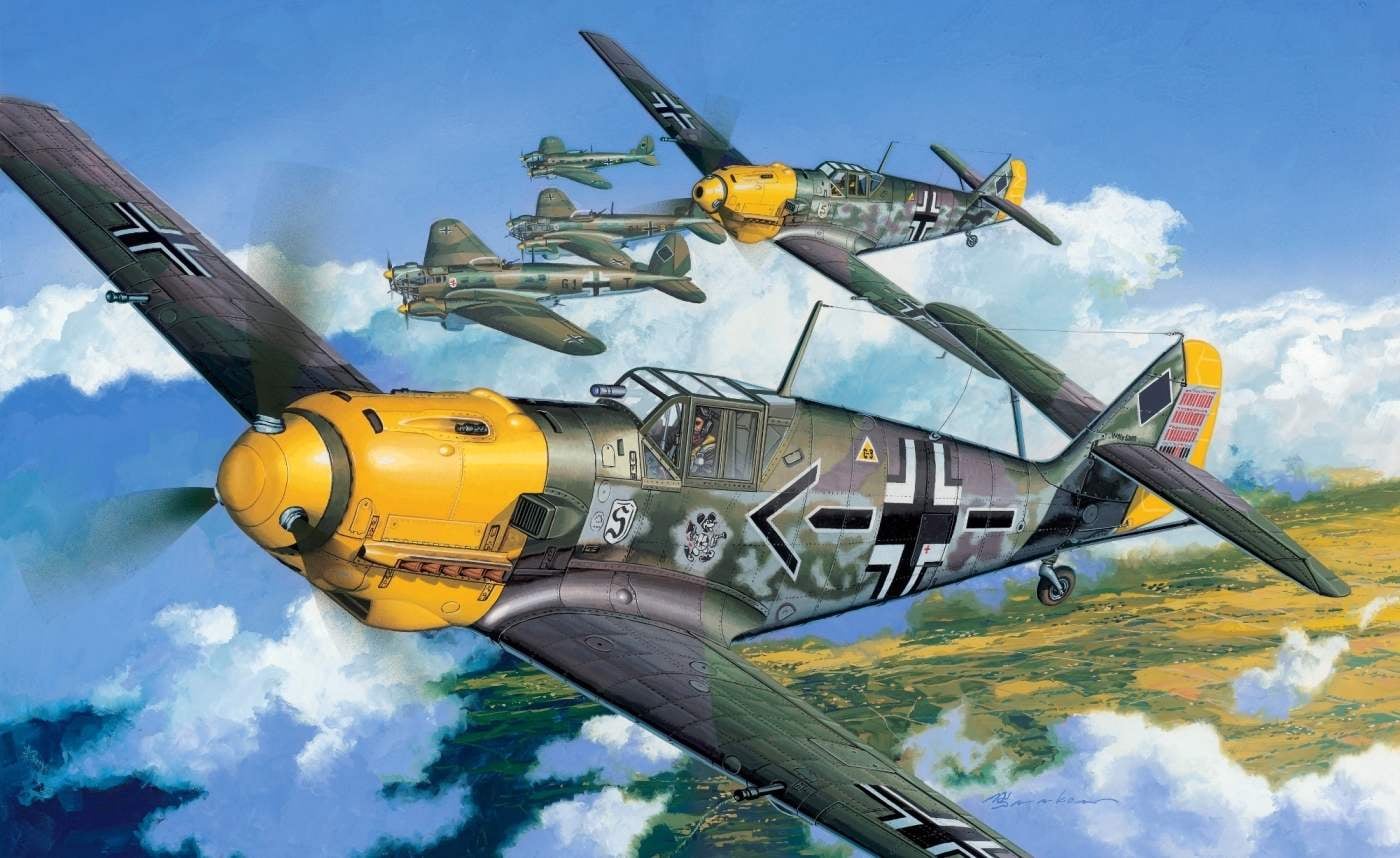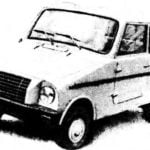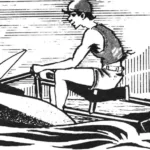 Fighter Messerschmitt BF-109 first modifications. The Treaty of Versailles in 1919, signifying the end of the first world war, significantly limit the military potential of Germany. The Germans were allowed only to have a 100-strong land army, devoid of all heavy military equipment, but German industry was forbidden to carry offensive weapons.
Fighter Messerschmitt BF-109 first modifications. The Treaty of Versailles in 1919, signifying the end of the first world war, significantly limit the military potential of Germany. The Germans were allowed only to have a 100-strong land army, devoid of all heavy military equipment, but German industry was forbidden to carry offensive weapons.
However, in may 1922, the ban on restrictions in the sphere of development of civil aviation Germany has been removed, which gave impetus to the revival of its aviation industry. There are many new airline companies, among whom was the firm Bayerische Flugzeugwerke AG (Bavarian aircraft factories) — BFW, which cooperated with 25-year-old designer Willy Messerschmitt. The Germans, however, were allowed to build only light aircraft, but the absence of a prohibition on placing orders outside of Germany allowed them to produce larger machines that are close to the bombers class.
Such a miscalculation of the allies gave the Germans the opportunity to begin the revival of the German air force. The first stage of this process was the creation of a network of aviation schools and the involvement of youth in aviation activities. Then began the development of modern combat aircraft that were issued for sports or passenger car.
After coming to power of Hitler in January 1933 began a large-scale construction of the air force, which it was impossible long to keep secret. Next year, Germany officially announced the formation of the first fighter squadron in Döberitz. However, the part is officially called Reklame-Staffel Mitteldeutschland, that is “Advertising squadron”, but it only emphasized her assigned task — to promote the emerging aviation power of Germany.
The first production combat aircraft such as, for example, fighter-biplanes are Not-51 — began to arrive in the order of the Ministry of aviation in the beginning of 1935. This allowed Hitler on 1 March 1935 officially announced the creation of the German air force, which was a clear violation of the Versailles Treaty.
In 1933, when Hitler came to power, firm BFW was in a very difficult financial situation, surviving on small orders. However, two years later, the situation began to improve, and in 1935 the company received a huge order for the production of 90 aircraft AG.66, 115 — 145, 70 — No-45, 35 — Ne-50 and 32 — Bf-108.
Bf-108, designed by W. Messerschmitt, was a monoplane and was considered a multi-sport aircraft. In the summer of 1934 on the basis of this machine for the Ministry of aviation began development of a new high-speed fighter. The same order was given and the eminent German firms Неinкеl, Aгado and Fоске-Wulf. The prototype of these companies had to go through comparative trials in travemünde.
The concept of the new fighter V. Messerschmitt made the most of the experience in the development of quadruple Bf-108. In particular, the new aircraft had the same slotted slats and flaps, and a fully closed canopy pilot. But Parking angle V. Messerschmitt chose for the fighter, more than a sports Bf-108, — smaller take off distance was for the fighter option is more important than some deterioration of visibility from the cockpit during takeoff and landing. For aircraft, the planned new engine Junkers Jumo-210 with a capacity of 610 HP, however, the firm failed to deliver it by the due date and on the first copy of the fighter BM09V-1 with serial number 758 in September 1935 had to install the English 695-horsepower Rolls-Royce “Kestrel” V.

Fighter planes MESSERSCHMITT Bf-I09B, Bf-109C and Bf-109D:
1 — canopy cockpit; 2 — flap filler fuel tank; 3 — hatch access to the radio; 4 — lifting pipe; 5 — keel; 6 — directions 7 — the tail marker light; 8 — control rod rudder; 9—removable top cowlings of the engine; 10 — a removable lower cowl of the engine; 11 — maintenance hatch; 12—house of hoods; 13 — spinner pitch; 14 — hood water radiator; 15—exhaust pipes; 16 — trimmer of the rudder; 17 — cable antenna (early version); 18 — antenna; 19 — opening of the lantern; 20 — glazing the backlight of the dashboard; 21 — the carburetor air intake; 22 — guns MG17; 23 — folded panel of the engine; a 24 — fairing-wing; 25 — operating hatch; 26 — tripping; 27 — hatch access to a pull system for the rudder stabilizer; 28 — brace stabilizer; 29 — metal variable-pitch propeller; 30 — handrail; 31—rope antenna (later series); 32—tail wheel; 33 — rocking of ailerons and flaps; 34—horn compensation of the rudder; 35 — wood screw with a constant pitch; 36 — spinner; 37 — wheel main landing gear; 38 — weight compensation of the Aileron
After a few test flights Bf-109V-1 received a civil code registration D-IABI and it was brought to Rachlinski test center. During landing the pilot had damaged the chassis. At the end of October after a brief repair Bf-109V-1 flew for comparative trials in travemünde.
The victory of V. Messerschmitt fighter over the aircraft rivals a He-112V-1, Ar 80V-1 and Fw 159V-1 et seq. the contract for construction of 10 Bf-109V-1 was a complete surprise for the competitors, who at that time still did not perceive and designer, and his plane seriously. The first three cars were collected by the end of 1936. Two of them — the Bf-109V-2 and Bf-109V-3, equipped with regular engines Junkers Jumo-210A, first off, respectively, in January and June 1936.
Fighters V. Messerschmitt was a possibility of installation of two machine guns MG-17 rifle caliber. Rumors about armed with the latest British fighters guns forced the designers to think about strengthening the arms of the Bf-109. It was decided to install three machine guns, one firing through the propeller spinner. MG FF cannon appeared on the Bf-109V-4 — it was installed in the collapse of the cylinders of the engine.
Seven cars out of ten ordered have been collected in the first half of 1937. The first serial fighter of the 109-th family became Bf-109B (option “A” existed only on paper).
The increase in military orders forced the leadership of the company BFW to expand production, but to meet the growing needs of the company couldn’t even built one and a half kilometres from Augsburg the new shop. The situation improved when V. Messerschmitt registered a new aviation firm Messerschmitt GmbH and acquired a plot of land in Regensburg started the construction of aviation enterprises. On the construction of plants, purchase of equipment and the establishment of production it took him only 16 months. According to the plans of V. Messerschmitt, the main production took place in Regensburg, and Augsburg was to be released the first batch of production vehicles and to house a pilot production.
The rapid establishment of the production of the aircraft contributed to the very high-tech design. The fuselage was made of two halves connected at the top and bottom. Each half had power set of longitudinal spars and transverse ribs, through which passed the stringers. Single-spar wing connected to the fuselage by only three points — it could fix even one person. Serial fighters differed from the prototypes by the location of the oil cooler, which moved from under the bow under her wing. The fuselage of the 250-litre fuel tank was located almost under the pilot’s seat.
Testing Bf-109 index V-4, V-5 and V-6 showed that the Central machine gun after several bursts have seized from overheating, so the BF-109B-1 began to arrive in part without him. The project includes installation of radio FuG-7 R/T, but the first car did not put.
The first production BF-109B-1 rolled out of the workshop in Augsburg in February 1937.
This and subsequent aircraft began arriving in the oldest fighter squadron Germany JG 132 “Richthofen”. It was planned at first to equip the new machines of the second group of the squadron in Gteborg-Damme, followed by the first in Döberitz. The next squadron was in queue JG 234 “Schlageter” in Cologne.
Re-equipment plans were broken by the plight of the German aircraft in Spain, where the Soviet I-15 And I-16 had complete superiority over the obsolete Not-51. This forced the Germans to send part of the 88th aviation group of the Legion “Condor” the first aircraft from the second group of the squadron “Richthofen”.
Fighter MESSERSCHMITT Bf-109E:
1 — three-blade metal variable-pitch propeller; 2 — suction pipe; 3 — detachable hood; 4 — opening of the lantern; 5 — rail; 6 — flap compartment radio; 7 — lifting pipe; 8 — pin cable mount antenna; 9 — control rod rudder; 10— front tail wheel; 11 — footboard; 12 — a radiator; 13 — hood oil cooler; 14—spinner; 15 — fuselage machine gun; 16 — suction nozzle; 17 — the canopy pilot; 18 — antenna; 19 — the fuel filler flap the fuel tank; 20 — cable the radio antenna; 21 — brace stabilizer; 22 — exhaust pipes; 23 — motor; 24 — the ventilator; 25 — the tail wheel in the retracted position; 26 — wheel main landing gear; 27 — main landing gear
During the development of the new fighter appeared some of its shortcomings, the main of which was the buffeting of the ailerons at high speed, the tendency to lowering of the left wing on takeoff and landing, and unexpected stalling of the aircraft in some flight modes. But all this could easily fend off a well-instructed by the pilot.
It was built about 30 planes the BF-109B-1. In 1937 rose in the air following the modification of the fighter — BF-109B-2. The prototype for it was the BF-109V-7 with the engine Jumo-210G.
The new fighter was fulfilled direct fuel injection into the engine cylinders, allows to keep stable its energetic combat maneuvering aircraft, as well as two-speed supercharger and an automatic gas control.
The new engine has not yet reached the stage of test and production aircraft are not yet established — ВМ09В-2 was powered by Jumo-210D and engines Jumo-210G were equipped with only the last aircraft of this series. Released fighters almost immediately sent to Spain, the first squadron of the 88-th group of the Legion “Condor”.
The first official presentation of the new German fighter of world aviation community took place in late July 1937 at the IV International air meeting in Zurich. The German team was represented by five prototypes of the Bf-109 and Bf-109V-8 and Bf-109V-9 was the Jumo-210G with direct fuel injection into the cylinders, a Bf-109V-10 and BM09V-13 equipped with engines Daimler-Benz DB-600A.
One of the pilots of the German team was known E. Udet, assuming your Bf-109V-10 to win the contest of combat aircraft. However, during the race, “the Circle of the Alps” his fighter’s engine failed, and E. Adetu had to make an emergency landing. The plane was completely wrecked. But the prize still went to the German major Hans Seidemann, flying the Bf-109V-8. He flew 365-km route in 56 minutes and 47 seconds at an average speed of 385 km/h. the German team took home the prize for best team race and individual time trial (four laps on a closed 50-mile route). Karl Franke on the Bf-109V-8 won the competition for the climb and dive he scored a height of 3 thousand meters and dived to a height of 150 m for 2 min to 5.7 s. After these brilliant victories at the international air rally of manufacture of the Bf-109 was dramatically increased. Licenses for the production of fighter V. Messerschmitt was also sent to several German aircraft companies.
A few months later — November 11, 1937 year pilot G. Wurster on the Bf-109V-13 set a world speed record for land planes — 607 km/h. the Pilot made two passes at the distance of 3 km and an altitude of about 75 m. To achieve this speed, the Bf-109V-13 was equipped with an uprated engine Daimler-Benz DB-601 power 1650 HP
Set the record and the successful use of fighter in Spain brought the Messerschmitt international fame. The firm began to visit foreign delegations for the purchase of the Bf-109 or Dating with his design.
The following modification of the Bf 109С was created on the basis of the Bf-109V-8, Bf-109V-9 and Bf-109V-10. Machine was a new radiator a larger cross-section, modified exhaust pipes and two additional wing guns with ammunition 420 rounds per gun, located close to the niches of the main wheels of the chassis. Test firing wing machine guns revealed the need to strengthen the leading edge of the wing. Production aircraft began to establish the radio station FuG-7 R/T, which allowed pilots to improve communication in the air. The radio was also on some copies of the earliest versions of the fighter.
New Bf-109C-1 in July 1938, was sent to Spain, where they were incorporated into the third squadron 88 th aviation group. At the same time with the BF-109С-1 in 88-th group did Not-112V-0. At the airport of Teruel aircraft overflew known as Franco G. Morato, which gave the plane V. Messerschmitt higher than car E. Heinkel. The opinion of the Asa was crucial — Franco asked Germany for its air force that fighter Bf-109С-1.
The first country that was allowed to buy new German fighters, was Switzerland. The first Bf-109B, equipped with an engine Jumo-210D, was sent to the customer in December 1938. The equipment and weapons mounted on fighter in Switzerland.

In the autumn of 1937 received an order for a series of planes with a 12-cylinder DB-600A. The aircraft was assigned the designation Bf-109D-0. The main external difference between the new modification was the replacement of the wooden screw of the metal pitch, which is produced in Germany under license and has already been installed on the BF-109B-2. The aircraft of this modification had better characteristics than previous versions. It was seriously strengthened its armament — two synchronized machine guns were added to 20-mm cannon MG FF/M ammo-160 rounds, combined with the engine into a single structure; the barrel of a gun was located in the hollow shaft of the screw.
On the modification of D-1 from the gun had to be abandoned because it was not too reliable. The vacated space was used to increase the ammunition of machine guns 1000 rounds each. Option D-2 were produced with two additional wing guns. The increased aircraft weight adversely affected its maneuverability — in particular, slightly increased the radius of the bend. Another unpleasant feature was the increase in stall speed.
Changes in alignment after the installation of the heavier engine was offset adjustable stabilizer angle relative to its neutral position can be varied from +3 to – 8 degrees. However, the mechanism of the stabilizer control was unreliable and frequently refused in flight when exposed to large overloads, especially at the exit from the dive. In all there were about 200 fighters Bf-109D with engines DB-600.
In late 1940, the aircraft began to retire. The most radical modification of the Bf-109 period of the Spanish war was the fighter of the series “E”. It was an airplane cleaner in aerodynamic respect. Large radiator liquid cooling system of the engine in the nose of the car lost his seat a little cooler, for cooling the engine used two small radiator, located in Palautordera position under the wing.
The design of the wing of Bf-109E has been strengthened. Good maneuverability was provided by a high wing loading and a powerful engine. On a new modification set engine DB-601 power 986 HP, geometrical and connection dimensions of which coincide with the size of the DB-600. Is the carb on the DB-601 was used direct injection of fuel into the cylinders, increasing the compression ratio in the cylinders of the engine from 6.5 to 6.9. Was also strengthened supercharged, and the supercharger equipped with an automatic control system of pressurization with hydraulic drive. The air intake of the supercharger brought over the exhaust pipes on the left side. The capacity of the fuselage fuel tank was brought to 400 l. the Engine spun a three-blade metal propeller to be modified electrically step.
The cabin of the new model was a close as the first Bf-109, with a closed review back and poor forward visibility on landing. Chassis with a narrow track often led to accidents on the ground when you run and run. Like all the previous Bf-109, the machine tended to crash during the run on the left wing. Pilots have complained that they can not control the trim tabs from the cockpit (the trimmers were unbent on earth) and, as a consequence, to control the plane had to make quite a big effort.
Specifications of fighters Bf-109 first modifications

In a dogfight the plane behaved steadily and was quite maneuverable for a monoplane. At low speeds approaching stall speed started light buffeting. The release of the flaps, and pushes the critical speed by 20-25 km/h.
Ten pre-production Bf-109E-0 armed with two wing and two synchronized machine guns, was built at the end of 1938 . On the first series of the BF-109E-1 instead of wing machine guns mounted two guns MG FF ammunition of 60 shells per gun. Now the pilot could water the enemy lead with a speed of 132 kg/min there was a possibility of a suspension plane four 50-kg bombs or one caliber 250 kg.
Fifteen first BF-109E-1 was in Spain in the late spring of 1939, when a civil war is almost over.
N. Food reserve was, A. CHECHIN
(To be continued)



